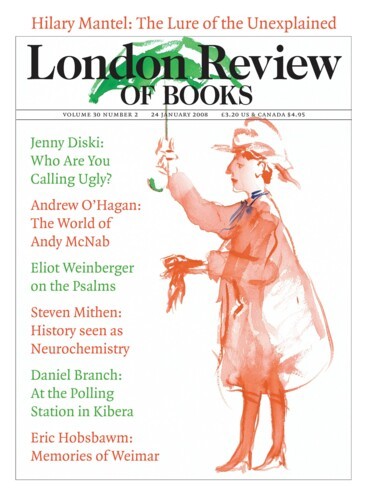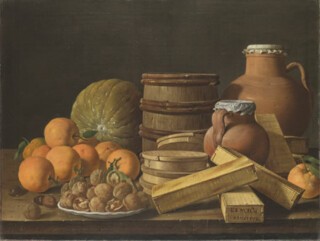One’s feelings about having one’s appetite tickled by pictures depicting food are at best ambivalent. Willem Kalf’s mid-17th-century painting in the National Gallery of a lobster, cooked to a brilliant scarlet and accompanied by glasses of wine, bread, a peeled lemon and an elaborate silver-mounted drinking horn – the original horn is in a museum in Holland – is perfect in its detail. But the insistent surfaces, the glitter of the crustacean’s shell and the luxury of it and its trappings, are so meticulously described that you can feel, as you can looking at the perfect photographs in a recipe book, that it is too good to be true. This is a pin-up of a lobster. It may look lovely, but it’s not really meant to be eaten. It rouses only to disappoint.
Two hundred years later Courbet, whose paintings of women, dead fish, game and fruit (particularly apples) are all insistently fleshly, takes food out of the ‘look but don’t touch’ regime and puts it on the table. The National Gallery has a Courbet of apples and a pomegranate. The fruit is packed tightly on a dish; blemishes and spots are recorded. You can argue that it is the paint you respond to rather than the fruit, but memories of apple-eating have their place. Chardin – none of whose fruit and food pictures are in the collection – also melds the deliciousness of the picture and the food that is its subject. Cézanne’s still-life apples (the only examples here are in an unfinished picture) have neither Kalf’s verisimilitude nor Courbet’s sensuousness. The question of what they would be like to eat does not arise. The appetite we have for this picture is cerebral rather than animal.
The deliciousness of a picture can exploit or circumvent squeamishness. Tortured saints and dead children can be made beautiful; dead animals can too. Perhaps only a particular kind of modern conscience could find anything untoward in a picture of men cheerfully returned from the hunt with the mallard, rabbit (or is it a hare?) and deer they have killed. That is what Joseph Parrocel shows in a painting of around 1700: when still furred and feathered as they are here, or in Jan Weenix’s study of a hound and game, dead creatures trigger a tactile appetite – how would it feel to stroke the fur? – rather than a culinary one. The single detail I found in a painting in the collection that would turn the stomach of those who share Walter de la Mare’s repugnance (‘But oh, the sawdust butcher’s shop/That ugliest of sights!’) is in Dou’s A Poulterer’s Shop. A woman bargaining for a hare (or is it a rabbit?) rests on the counter a shiny bucket from which the paws and head of a skinned one protrude, the eyeball intact and a drop of blood gathering on its nose. The colour scheme of muscle and viscera (pink and red flesh, creamy fat, blue-grey veining) is one of nature’s prettiest and Dou’s meticulous account of textures and surfaces does it credit. To make an animal, killed and skinned, part of a decorative anecdote is, I guess, unexpected only to a generation that usually buys its poultry ready drawn, plucked and beheaded.
But the greatest dead-animal paintings have always shown the facts of carnivorousness in a way that makes us confront our animal selves. The Louvre has two of them: Rembrandt’s Flayed Ox and Goya’s still life of a sheep’s head and meat. Both take you away from the fur and plumage of hung game in the larder to the bloody facts of the shambles. Rembrandt’s Ox makes you think of his Crucifixion; Goya’s severed sheep’s head of his Disasters of War. Our appetite for flesh to eat is triggered by the cooked joint, not the bleeding corpse. Paintings like these mix pity, horror and uneasy curiosity about the secret world of animal – and therefore of our own – insides. The mix of fascination and repugnance at the visceral facts goes deep. Soutine’s paintings of bird and animal carcases, and others by Francis Bacon (like Figure with Meat, Velázquez’s Innocent X backed by sides of beef), draw on these responses.
Decorative food – game trophies, horns of plenty – often doesn’t have much to do with eating. Who would dare destroy the arrangement by taking down the pineapple that tops van Os’s Fruit and Flowers in a Terracotta Vase? In Caravaggio’s Supper at Emmaus a basket of fruit like those he painted as still lifes projects precariously over the edge of the table. It is surely there at least in part for show, like the cellophane-wrapped baskets we send to friends in hospital or the tray of apples and grapes in Poussin’s Adoration of the Shepherds. On the other hand, the fruit tumbling from a horn of plenty held by a satyr in Rubens’s Peace and War has a Courbet-like substantiality. A cupid distributes grapes to children (those of Rubens’s patron); food is here shown as symbol and as sustenance.
Frugality and simplicity can have more symbolic force than plenty. Seventeenth-century Spanish painters (who are equally reticent about naked flesh) show the power of restraint. In an early Velázquez, Christ in the House of Martha and Mary (on loan to the Prado), the action of the title – puzzlingly seen through a rectangular hole in the wall, or perhaps that hole is a mirror or a painting – is the excuse for a kitchen scene. There is a maid with a mortar and pestle, fish in a bowl, eggs, garlic and a chilli. Caravaggio had prepared the way for this kind of strongly lit still life, but the separation of objects waiting to be cooked, each given individual attention, is Spanish. It is what also strikes one in Sánchez Cotán’s paintings of fruit and vegetables strangely suspended on strings, or in Zurbarán’s rows of pots and baskets of fruit. Later, Luis Meléndez, in paintings like the National Gallery’s Still Life with Oranges and Walnuts, piles things close together – boxes, jugs and barrels as well as fruit and nuts. But here too food is taken seriously, as a necessity, not tumbling out in generous superfluity.
Bread is symbolically the most powerful of foods. In Le Nain’s picture of peasants, A Woman and Five Children, the dish on the table is empty. In Four Figures at a Table a boy cuts a loaf and you would be surprised to find that the jug the girl holds has anything other than water in it. That dumpy, generic loaf is very like those you hardly notice on richer tables like Kalf’s. In Zurbarán’s Adoration of the Shepherds a boy holds a basket of loaves. The trussed lambs in the foreground of this picture are also symbolic, sacrificial food. In Poussin’s Last Supper (Eucharist in his series The Seven Sacraments), only bread and salt are on the table that Christ and the disciples gather round – lying on couches in the Roman fashion.
Modern superfluity has compromised the symbolism of feasts and frugality. The most memorable images of food from the last fifty years or so deal in the gross and the oversweet. There are Claes Oldenburg’s monster fruits and giant, stuffed models of hamburgers, sandwiches and cake. There are Wayne Thiebaud’s pictures of pies, cakes and candies. And, of course, all those cans of Campbell’s soup.
Send Letters To:
The Editor
London Review of Books,
28 Little Russell Street
London, WC1A 2HN
letters@lrb.co.uk
Please include name, address, and a telephone number.


